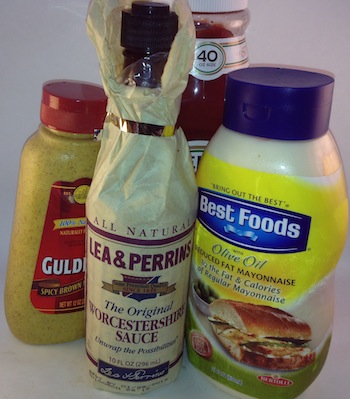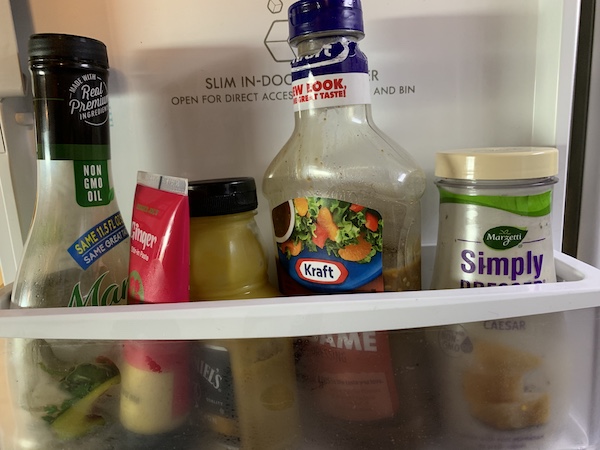Which Condiments Need Refrigeration?
We’ve found out in previous EatByDate posts that condiments like ketchup and soy sauce are pretty shelf stable, so much so that even once opened they can be left to sit right out on the counter. Let’s now explore a whole list of condiments and see whether they also can remain safely on the counter or, for safety reasons, they should always be stored in the refrigerator.

Which Condiments Need to be Refrigerated?
Some like it hot, some like it cold.
Do Condiments Need Refrigeration?
Let’s take a look at some common condiments
and see whether they are OK to sit out on the
counter or in the cupboard or if they are much
better off if placed into the refrigerator. If
there’s an asterisk (*) next to the product
answer, then be sure to read the full explanation
for that product.
| Item | Refrigeration Required once Opened? | More Info |
|---|---|---|
| Barbecue Sauce | No | For long term storage, beyond a month, refrigeration is recommended. |
| Butter | No* | *For long term storage, Yes! See our butter post for information os the short and long term storage of butter. |
| Cocktail Sauce | Yes | The ketchup ingredient doesn’t need it, but the horseradish does so store cocktail sauce in the fridge. |
| Fish Sauce | No | This product is fermented so the fridge really won’t help. |
| Hot Sauce | No | Sauces can vary, so check the label and/or ingredient list, but most hot sauces are just fine on the counter. Most are highly acidic and can last years on the shelf. Who wants cold hot sauce anyways! |
| Honey | No | Do not ever put honey in the refrigerator. |
| Horseradish | Yes | Whether the the fresh root or ground paste – to keep it hot… keep it cold! |
| Jam/Jelly | Yes* | *According to Smuckers, a major manufacturer of jams and such, “for maximum freshness and flavor, we do not recommend using opened products if they have been without refrigeration for more than 48 hours” [1]. So, if you take these guys camping, be sure to pop them in the fridge when back home. |
| Ketchup | No | If a bottle takes you forever to finish, beyond a month, then refrigeration is recommended. |
| Mayonnaise | Yes | Never leave mayo or other sauces that contain mayonnaise as an ingredient out on the counter for more than 2 hours. Food poisoning may occur as a result of ignoring this rule. |
| Molasses | No | This product is extremely shelf stable. |
| Mustard | No | Some combination products may require refrigeration once opened – not because of the mustard, but possibly due to an egg, milk or cream ingredient being added to the product. If your mustard lasts longer than two months, then refrigeration is recommended. |
| Oil | No | Some of the more delicate oils (like grapeseed, avocado, almond and sesame) will benefit from refrigeration to delay rancidity. |
| Onions | Yes | Due to the high water content of onions, shelf life increases greatly if cut or peeled onions are refrigerated. (P.S. The internet rumor that onions become poisonous when refrigerated is completely false.) |
| Oyster Sauce | No | This product is fermented so doesn’t need refrigeration. Although, refrigeration is generally recommended for longer term storage once opened. |
| Peanut Butter | No | Natural peanut butter can be refrigerated to keep it from separating, which is an advantage but not a necessity. |
| Pickles | No | The fridge does keep them crunchier, so may be preferred storage for most people. Also, sweet pickles will remain sweeter if stored in the fridge. |
| Relish | Maybe | Relishes can be made of different things in different ways, but most are fermented vegetables that can handle being on the counter for a few days. After that, the fermentation will begin to eat up all the natural sugars. So, for sweet pickle relish refrigeration is recommended to keep the relish both sweet and crunchy. |
| Salad Dressing | Maybe | Many Italian dressings or Vinaigrette dressings that are made with oil, vinegar and simple spices like salt and pepper do not need refrigeration. Most all creamy type dressings do need refrigeration. If the dressing was purchased in the refrigerator section of the store, place it into the refrigerator upon arriving home. If it was purchased on the shelf and includes ingredients other than those mentioned above, then it should also be placed into the refrigerator after opening. If in doubt, refrigerate. |
| Sauerkraut | No | Short term storage of this fermented product can be on the counter, but it will last longer in the fridge. |
| Kimchi | No | This fermented product can last on the counter for at least a week. |
| Schiracha | No | This hot sauce is made with all shelf stable ingredients so sits fine on the counter. Do check the label if it is a Schiracha product (such as schiracha mayo), as added ingredients may force refrigeration. |
| Soy Sauce | No | Since soy sauce is a fermented product, it is shelf stable. |
| Syrup | No* | Due to the low moisture count of syrups, refrigeration is not needed. Regular pancake syrups should never touch the fridge. But, to keep pure maple syrup at its finest and extend its shelf life, *refrigerate pure maple syrup after opening. |
| Vinegar | No | Vinegar, a natural preservative, is extremely shelf stable. |
| Vinegarette | Maybe | This depends on the other ingredients in the bottle. A simple oil, vinegar, herbs and spices recipe would be fine on the counter while any additions may require refrigeration for longer storage. |
| Worchester Sauce | No | This product has been fermenting for years before purchase, the fridge won’t help. |
Most foods, whether packaged or fresh, will eventually experience slight changes in color, texture and/or flavor as periods of time pass. This can be a short or long process, depending on the product. Variables like exposure to heat and sunlight will speed this process along.
Things to keep in mind when deciding where to place condiments:
If it is used daily, then it’s much more convenient on the counter
Some people prefer condiments at room temperature while others prefer them to be cold.
FYI the door is most often used for condiments since most condiments don’t really need the refrigerator. (and because of the constant opening and closing the door is the warmest part of the fridge).

Most of these products enjoy a cool, dark place. Ideally, this means 50° F to 60° F, but never to exceed 75° F. If the kitchen has a pantry, that’s perfect. If the kitchen is too hot; whether due to outside temperatures, an active oven or excessive windows, then the refrigerator may be a better choice for many of these products. This is especially true if they need to be kept around for more than a few days.
Jars can attract double dipped utensils, especially when just sitting out on the counter. This can lead to food spoilage of another product that made its way into the container of a shelf stable product.
Do Condiments Need to be Refrigerated?
How about Condiment Packets?

What about those tiny packets of condiments
available at fast food joints?
They sit out all day, even mayonnaise packets
– is that OK?
As long as they are properly sealed, these packets
can continue to sit out for appropriate times beyond
their best by date as defined on each of their
individual EatByDate pages. Keep in mind that they
should still be kept out of direct sunlight and
extreme heat. The problem is that the box of
condiment packets carry the best if used by date and
not the individual condiment packets. So, the
restaurants know the dates and place them out for
use accordingly, but the consumer that saves the
unused take-out packages has nothing to go by
– that’s when the “how to tell if
xxx (condiment) is going bad” section of
EatByDate should be checked.
Additional Information
Find out more about some of the most common condiments and their refrigeration needs here: ketchup, butter and soy sauce.
To find out how long ketchup lasts, see our ketchup page.
To find out more on the dangers that can be involved when the wrong raw foods touch, see our post on cross contamination.










